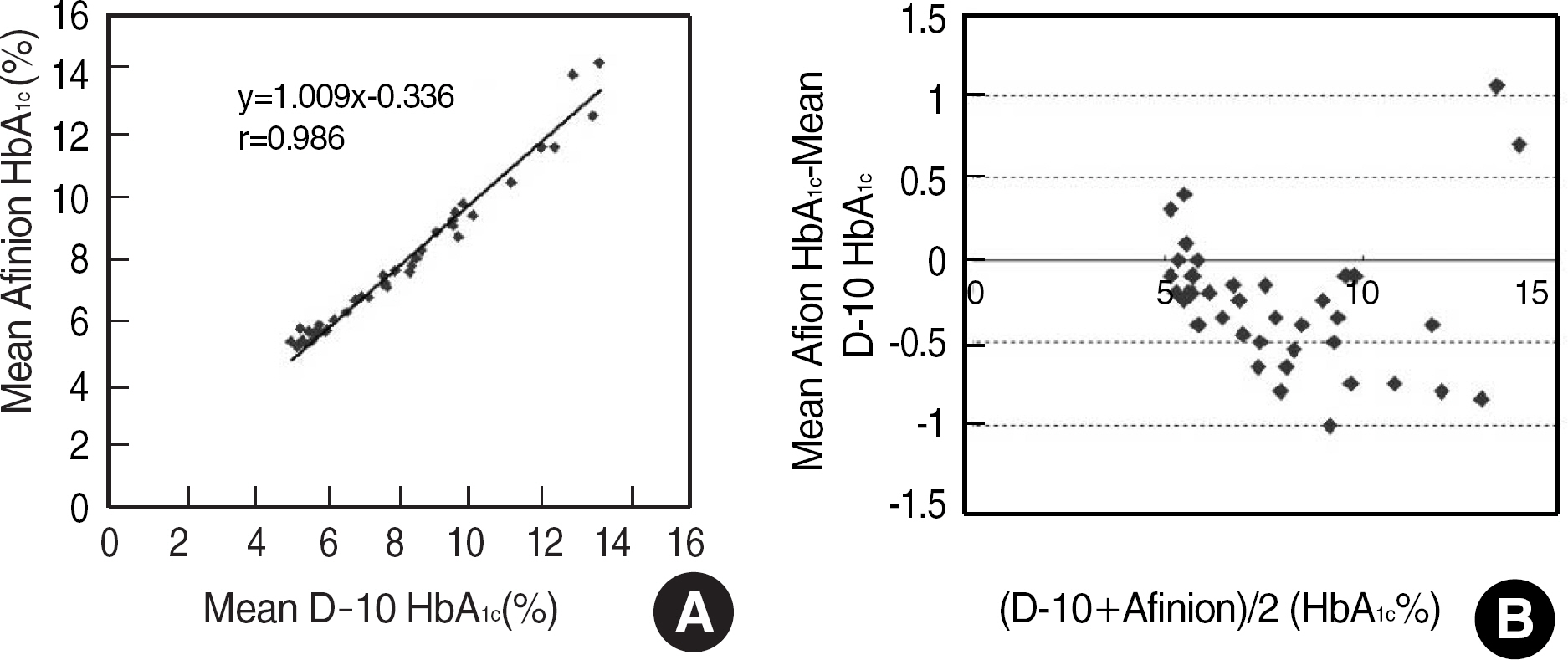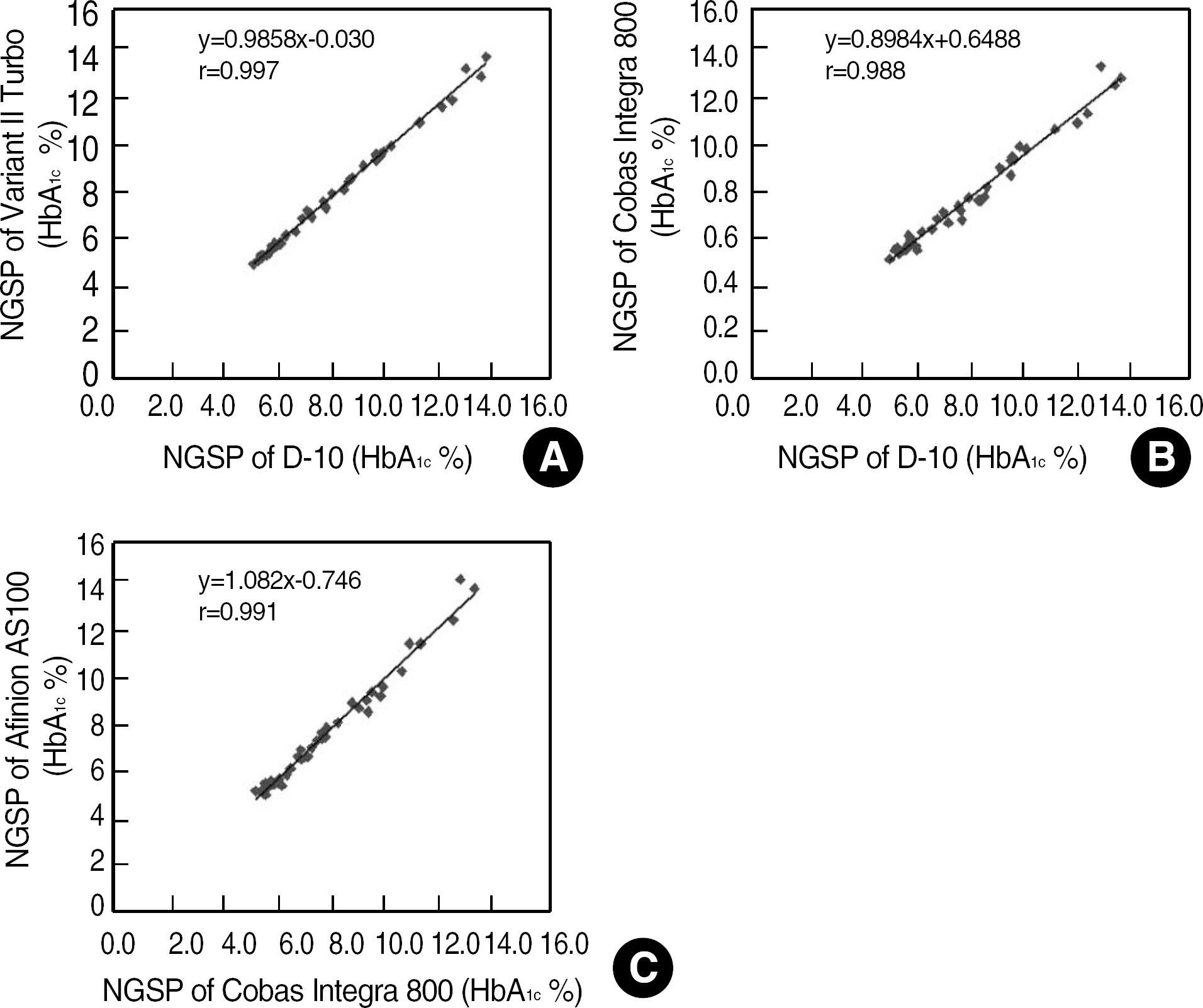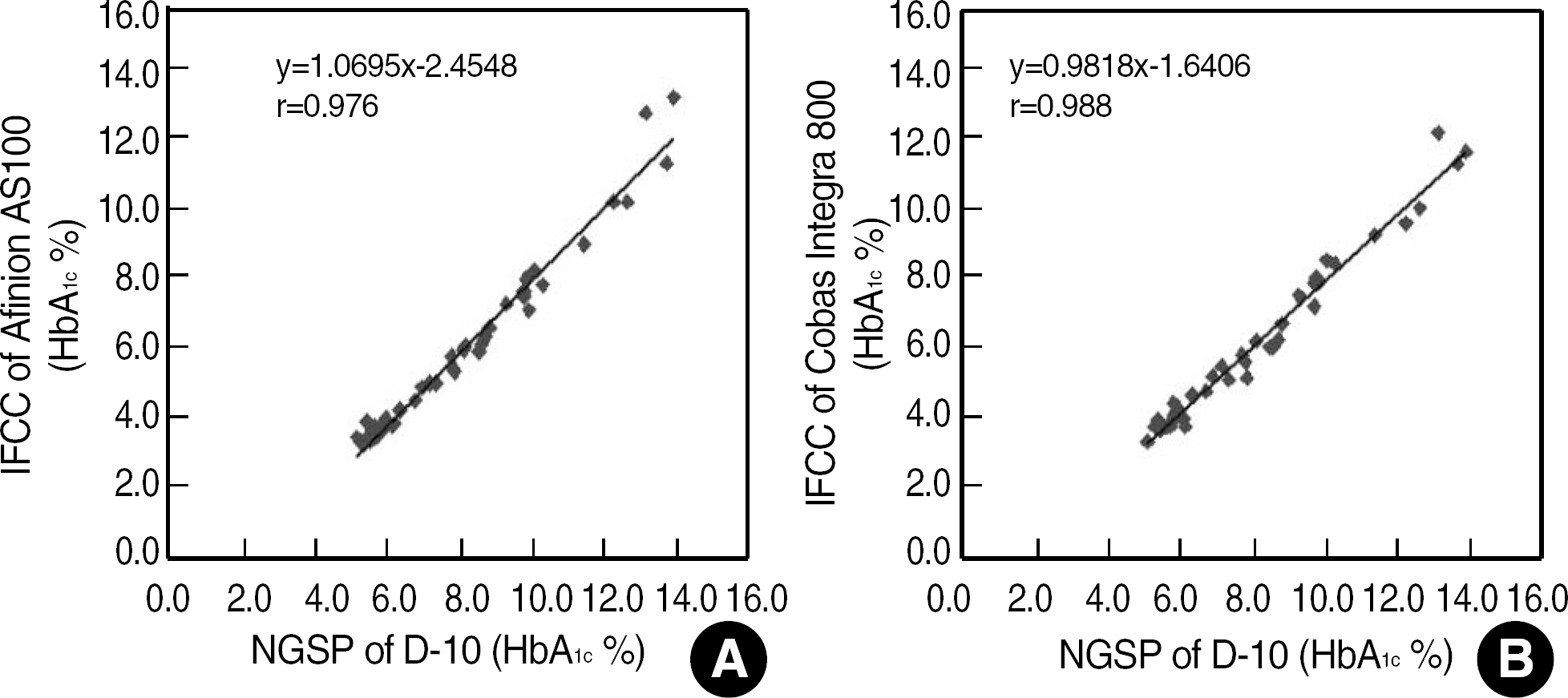Korean J Lab Med.
2010 Aug;30(4):345-350. 10.3343/kjlm.2010.30.4.345.
Comparison of HbA(1c) Analyzers: D-10, Variant II Turbo, Cobas Integra 800, and Afinion AS100
- Affiliations
-
- 1Department of Laboratory Medicine, School of Medicine, Ewha Womans University, Seoul, Korea. kshong@ewha.ac.kr
- 2Eone Reference Laboratory, Seoul, Korea.
- KMID: 1781639
- DOI: http://doi.org/10.3343/kjlm.2010.30.4.345
Abstract
- BACKGROUND
The purpose of this study was to evaluate the performance and agreement among HbA(1c) values measured using selected analyzers certified by the National Glycohemoglobin Standardization Program (NGSP) and standardized by the International Federation of Clinical Chemistry and Laboratory Medicine (IFCC).
METHODS
HbA(1c) determined using D-10 (Bio-Rad, USA), Variant II Turbo (Turbo; Bio-Rad, USA), Cobas Integra 800 (Integra; Roche, Switzerland) and Afinion AS100 (Afinion; Axis-Shield, Norway) were compared with each other. Precision and method comparisons with Deming regression were evaluated according to CLSI recommendations. We also compared the HbA(1c) values obtained with each analyzer using either IFCC or NGSP methods by correlation analysis and kappa statistics.
RESULTS
The repeatability and method/device precisions of D-10 and Afinion were acceptable. The correlation coefficients of HbA(1c) were 0.986 for D-10 vs. Afinion, 0.997 for D-10 vs. Turbo, 0.988 for D-10 vs. Integra, and 0.991 for Integra vs. Afinion. The average biases of HbA(1c) Afinion (IFCC) and HbA(1c) Integra (IFCC) against HbA(1c) D-10 (NGSP) were -1.90% and -1.79%, respectively. Kappa agreement statistics for the three diabetic control group HbA(1c) values of "less than 6.5%," "6.5%-7.5%," and "greater than 7.5%" for D-10 vs. Turbo, D-10 vs. Integra, and D-10 vs. Afinion were 0.872, 0.836, and 0.833, respectively.
CONCLUSIONS
The strong correlations and good clinical agreements of HbA(1c) between each analyzer expressed in terms of either NGSP or IFCC-derived NGSP indicate that these analyzers can be used interchangeably.
Keyword
MeSH Terms
Figure
Cited by 1 articles
-
Analytical Performance of Bio-Rad D-100 on a Hemoglobin A1c Assay
Changseung Liu, Eunhye Choi, In Cheol Bae, Sang-Guk Lee, Jeong-Ho Kim
Lab Med Online. 2017;7(2):59-65. doi: 10.3343/lmo.2017.7.2.59.
Reference
-
1.Nathan DM., Singer DE., Hurxthal K., Goodson JD. The clinical information value of the glycosylated hemoglobin assay. N Engl J Med. 1984. 310:341–6.
Article2.Benjamin RJ., Sacks DB. Glycated protein update: implications of recent studies, including the diabetes control and complications trial. Clin Chem. 1994. 40:683–7.
Article3.Steffes M., Cleary P., Goldstein D., Little R., Wiedmeyer HM., Rohlfing C, et al. Hemoglobin A1c measurements over nearly two decades: sustaining comparable values throughout the Diabetes Control and Complications Trial and the Epidemiology of Diabetes Interventions and Complications study. Clin Chem. 2005. 51:753–8.
Article4.Little RR, Rohlfing CL, Wiedmeyer HM, Myers GL, Sacks DB, Goldstein DE; NGSP Steering Committee. The national glycohemoglobin standardization program: a five-year progress report. Clin Chem. 2001. 47:1985–92.5.Jeppsson JO., Kobold U., Barr J., Finke A., Hoelzel W., Hoshino T, et al. Approved IFCC reference method for the measurement of HbA1c in human blood. Clin Chem Lab Med. 2002. 40:78–89.
Article6.Kobold U., Jeppsson JO., Dülffer T., Finke A., Hoelzel W., Miedema K. Candidate reference methods for hemoglobin A1c based on peptide mapping. Clin Chem. 1997. 43:1944–51.
Article7.Hoelzel W., Weykamp C., Jeppsson JO., Miedema K., Barr JR., Goodall I, et al. IFCC reference system for measurement of hemoglobin A1c in human blood and the national standardization schemes in the United States, Japan, and Sweden: a method-comparison study. Clin Chem. 2004. 50:166–74.
Article8.Sacks DB. Global harmonization of hemoglobin A1c. Clin Chem. 2005. 51:681–3.
Article9.Penttilä IM., Halonen T., Punnonen K., Tiikkainen U. Best use of the recommended IFCC reference method, material and values in HbA1C analyses. Scand J Clin Lab Invest. 2005. 65:453–62.10.Mosca A., Goodall I., Hoshino T., Jeppsson JO., John WG., Little RR, et al. Global standardization of glycated hemoglobin measurement: the position of the IFCC Working Group. Clin Chem Lab Med. 2007. 45:1077–80.
Article11.Consensus Committee. Consensus statement on the worldwide standardization of the hemoglobin A1c measurement: the American Diabetes Association, European Association for the Study of Diabetes, International Federation of Clinical Chemistry and Laboratory Medicine, and the International Diabetes Federation. Diabetes Care. 2007. 30:2399–400.12.Marzullo C., Minery M. Evaluation of D10 hemoglobin testing system for hemoglobin A1c assay. Ann Biol Clin (Paris). 2008. 66:95–9.13.Leon-Justel A., Santotoribio JD., Dominguez-Pascual I., Delgado AL., Macias C., Herrera MT, et al. Influence of reduction in the elution times on HPLC glycohaemoglobin results. Clin Biochem. 2009. 42:1582–4.
Article14.Fleming JK. Evaluation of HbA1c on the Roche COBAS Integra 800 closed tube system. Clin Biochem. 2007. 40:822–7.
Article15.Tholen DW, Kallner A, editors. Evaluation precision performance of quantitative measurement method: approved guideline. CLSI document EP5-A2. 2nd ed.Wayne, PA: NCCLS;2004.16.Krouwer JS, Tholen DW, editors. Method comparison and bias estimation using patient samples: approved guideline. CLSI document EP9-A2. 2nd ed.Wayne, PA: NCCLS;2002.17.Song JH., Kwon KC., Kim JH., Kim JW., Min WK., Lee SY, et al. Annual report on external quality assessment in metabolic disorders in Korea (2008). J Lab Med Qual Assur. 2009. 31:143–59. (송정한, 권계철, 김정호, 김종원, 민원기, 이수연 등. 대사질환검사 신빙도조사 결과보고(2008). 임상검사와정도관리 2009;31:143-59.).18.Goldstein DE, Chenault VM, editors. Harmonization of gylcohemoglobin measurement. CLSI document C44-A. Wayne, PA: NCCLS;2002.19.Miedema K. Standardization of HbA1c and optimal range of monitoring. Scand J Clin Lab Invest Suppl. 2005. 240:61–72.
Article20.Dhatt GS., Agarwal MM., Bishawi B. HbA1c: a comparison of NGSP with IFCC transformed values. Clin Chim Acta. 2005. 358:81–6.
Article21.Paisooksantivatana K., Kongsomgan A., Khupulsup K. NGSP and IFCC-derived NGSP HbA1c can be used interchangeably. Diabetes Res Clin Pract. 2009. 85:e22–5.
Article22.Nordin G., Dybkaer R. Recommendation for term and measurement unit for “HbA1c”. Clin Chem Lab Med. 2007. 45:1081–2.
Article
- Full Text Links
- Actions
-
Cited
- CITED
-
- Close
- Share
- Similar articles
-
- Evaluation of HbA1c on COBAS INTEGRA 800 Closed Tube System Compared with Variant II Turbo
- Performance Evaluation of the Afinion AS100 Analyzer for Its Use in the Albumin Creatinine Ratio Test
- Evaluation of Hemoglobin A1c on the Cobas Integra 800 Immunoassay and Tosoh HLC-723 G8 HPLC Analyzer
- Performance Evaluation of HbA1c Test on the Toshiba 200FR NEO Using AutoLab HbA1c Reagent
- Evaluation of Cobas b 101 HbA1c Analyzer Performance for Point-of-Care Testing




